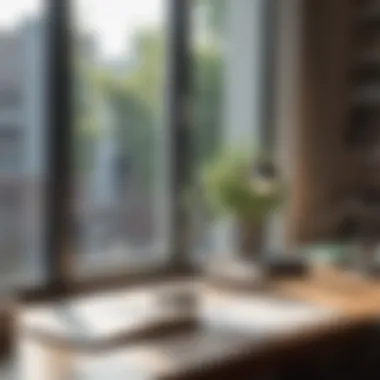Choosing the Best Lighting for Your Office Desk


Intro
In today's fast-paced world, the significance of a well-lit workspace cannot be overstated. The right lighting not only enhances the aesthetic appeal of an office desk but also plays a crucial role in productivity and overall well-being. Poor lighting can lead to eyestrain, fatigue, and an overall decline in mood, which is the last thing anyone needs while trying to meet deadlines. Conversely, selecting optimal lighting can create an inviting environment that encourages focus and creativity.
This discussion seeks to unravel the intricate layers involved in choosing the best office desk lighting. From understanding the types of lighting available to personal preferences dictated by one’s tasks and work style, we will embark on a journey that inspires homeowners, designers, and DIY enthusiasts alike to transform their workspaces into effective havens of productivity.
Furthermore, you might wonder how design trends can influence your choice of lighting. Let’s delve into some current furniture design trends that can guide your decisions.
Understanding the Importance of Office Lighting
Choosing the right lighting for your workspace isn’t just about making things brighter; it’s a multifaceted decision that can significantly alter your working experience. Office lighting plays a crucial role in enhancing productivity, influencing mental health, and creating an inviting atmosphere. These key aspects are instrumental in fostering an environment conducive to concentration and creativity, which is increasingly valuable in today’s fast-paced world.
Lighting acts as a framework within which the tasks of the day unfold. A well-lit office not only improves visibility but also underpins your ability to focus and follow through with intricate projects. Poor lighting, conversely, can lead to fatigue and decreased motivation. This underscores the need to understand how different lighting setups impact work performance.
Effects of Lighting on Productivity
Lighting affects various cognitive processes, such as attention and alertness. A 2018 study indicated that natural light exposure enhances mood and energy, leading to increased productivity levels among workers. When your desk is illuminated optimally, tasks become less of a chore; they flow smoothly.
- Natural light: Maximizing the use of windows and skylights can transform your desk into a thriving hub of creativity. It can help ward off the afternoon slump that many people feel.
- Task lighting: Desk lamps that direct light precisely to your work area enable you to focus better on detailed tasks without straining your eyes.
Moreover, lighting color matters too. Warm light can create a cozy atmosphere, making it easier for you to settle into a rhythm. Conversely, cooler tones may boost alertness, putting you in the right frame of mind for tackling challenging assignments. Thus, the type and angle of artificial lighting you choose are fundamental.
Impact on Mental Health and Well-Being
The influence of lighting extends beyond mere productivity; it seeps into mental health too. Insufficient or harsh lighting can create a feeling of discomfort and dread. For instance, studies have shown that workplaces with proper lighting design reduce feelings of stress and anxiety. A poorly lit environment can contribute to seasonal affective disorder, a type of depression that occurs at certain times of the year, particularly during the dreary winter months.
Think about it: a warm, well-lit workspace can ease tension. When you walk into a bright room, it often feels inviting. It tells your mind that it’s time to work. In contrast, dim and dreary spaces can sap your energy and enthusiasm.
"The right lighting can energize your workspace and elevate your mood, leading to profound improvements in both productivity and well-being."
Creating a Welcoming Workspace
The aesthetic element of lighting shouldn’t be overlooked. A well-lit office feels pleasant and inviting. People are drawn to spaces where they feel comfortable and positive. Think of your desk as an extension of your personality. When well-lit, it becomes a canvas for creativity.
- Flexible options: Considering accent lights that highlight your decor or photos can also imbue warmth into the space. These can add character while providing the necessary light for visibility.
- Use of lamps: Table lamps or floor lamps can offer a softer glow, helping to break the sterility of harsh overhead lights.
Your workspace lighting should not only serve a functional role but also embody the vibe you want to cultivate. Merging utility with aesthetics can create an environment that feels welcoming and inspiring, making it a place you look forward to each day.
By understanding the importance of office lighting, you set the groundwork for a workspace tailored to meet your needs, ultimately paving the way towards heightened productivity and well-being.
Evaluating Different Types of Lighting
When it comes to creating the ideal workspace, understanding the various types of lighting is crucial. Lighting isn’t just about visibility; it impacts your mood, productivity, and overall experience at your desk. Each type of lighting serves a specific function and meshes differently with your environment, which is why it’s important to evaluate them carefully.
From harnessing the sun’s rays to the electric glow of lamps, the interplay between different lighting types creates a unique atmosphere tailored to your workspace needs. Choosing wisely can transform your office from a dull spot into a sanctuary of creativity and focus.


Natural Light: Benefits and Limitations
The advantages of natural light are hard to overlook; it is a powerful tool for emotional and physical well-being. Sunlight not only helps regulate your biological clock but also boosts serotonin levels, which might help keep feelings of stress at bay. Like a gentle embrace, it lifts the spirits and can enhance creativity.
However, it's not without drawbacks. The angle of sunlight changes throughout the day, potentially casting shadows or creating glare on screens. Furthermore, not all office spaces are fortunate enough to have abundant natural light. For those who might not have large windows, there could be a challenge in fully reaping these benefits. But where there’s a will, there's a way—strategically positioning mirrors to reflect light might lessen these limitations.
Ambient Lighting: Establishing the Mood
Ambient lighting is like the backbone of your illumination scheme; it sets the stage and blends all the other types of lighting harmoniously. Generally, it offers a soft glow that fills the room without causing harsh contrasts. Think of it like the base coat of paint on a canvas—without it, everything seems incomplete.
This type of lighting enhances comfort and makes the space feel inviting. It could be achieved through floor lamps, ceiling fixtures, or wall sconces. Keep in mind, the color temperature of these light sources matters too, with warmer tones creating a cozy atmosphere that's friendly yet productive.
"Ambient lighting is more than just lighting; it’s about creating an environment that fosters comfort and focus."
Task Lighting: Focused Illumination
When it’s time to dig into work, task lighting becomes your best friend. This type of lighting is designed specifically to illuminate your work area, whether it’s reading, writing, or engaging in detail-oriented tasks. Desk lamps—especially those with adjustable arms—allow you to focus light precisely where it’s needed. Good task lighting is all about offering enough brightness to cut through that afternoon fog without straining the eyes.
This is particularly important for electronic activities. Blue light emitted from screens can cause fatigue over time, but combining it with the right task lighting can mitigate some of those issues. Consider different angles and heights for your light source, as this can change the dynamic of your workspace and help you achieve better focus.
Accent Lighting: Adding Depth and Interest
Accent lighting is the stylistic cherry on top; it draws attention to specific areas or decor elements in your workspace. While it’s not the primary source of light, it can dramatically affect the room's ambiance. Think of it as the finishing touch on a gourmet meal—petty yet impactful.
Using strategically placed LED strip lights or picture lights can create a sense of dimension and depth. In a home office, accent lighting might illuminate artwork or architectural features. It personalizes your space and can make long work hours a little more enjoyable by giving your environment flair. As a side note, it can also sometimes serve utilitarian purposes, like providing extra illumination to shadowy corners.
By evaluating these different types of lighting, you ensure not just visibility, but also an enriching workspace experience that caters to your needs and preferences. With the right mix, your office desk can emerge as a productivity powerhouse.
Key Features to Consider in Desk Lighting
Selecting the right lighting for your office desk isn’t just about picking the most stylish lamp or the brightest bulb. Rather, it revolves around understanding the crucial features that contribute to an effective workspace. These features interplay deeply with productivity and comfort. Lighting that doesn’t meet your specific need can lead to eye strain, fatigue, or even diminished output over time. Thus, taking the time to decipher what’s essential can pay off in the long run, creating a vibrant environment tailored to individual tasks and preferences.
Adjustability: Flexibility in Angle and Brightness
Adjustability in your desk lighting should be a top priority. When you have the option to manipulate both the angle and brightness, you’re essentially customizing the environment to cater to your activities. Imagine adjusting your lamp to throw light right on a document you’re reviewing without casting awkward shadows across your workspace. This flexibility can significantly reduce eye strain by allowing you to focus light where you need it most. Additionally, a dimmable lamp can create just the right ambiance for late-night brainstorming sessions or focused work periods. It’s about being in control of your workspace, allowing you to adapt to varying tasks and moods throughout the day.
Color Temperature: Warm vs. Cool Light
Color temperature can vastly influence the atmosphere of your workspace. Warm light, often in the range of 2700K to 3000K, creates a cozy feel that can make those endless hours at the desk more bearable. Think of it as wrapping yourself in a warm blanket while diving into a new project. On the flip side, cool light, ranging from 4000K to 5000K, mimics natural daylight, which can enhance alertness and focus. This type of lighting might be beneficial during those late afternoons when you feel the energy slumping. Knowing your preferences in color temperature can make a world of difference in maintaining optimism and focus during your work.
Energy Efficiency: LED vs. Traditional Bulbs
The debate between LED and traditional bulbs isn’t only about energy consumption, though that’s a significant factor. LED lights consume less power and have a longer lifespan compared to incandescent or fluorescent bulbs. The environmental benefits also cannot be overlooked—fewer bulbs mean less waste in landfills. Furthermore, several LED options now offer excellent color rendering, ensuring colors appear as they naturally would. Prioritizing energy efficiency not only benefits your wallet but also aligns with sustainable practices. When choosing desk lighting, considering these differences can help you make a more informed purchase.
Design Aesthetics: Blending with Your Decor
Lastly, design aesthetics play an important role in lighting decisions. This doesn’t just mean picking something that looks pretty—though that’s not insignificant either. The lamp or light fixture you choose should resonate with the overall decor of your workspace. A sleek, modern desk lamp might look out of place in a rustic environment, just as a vintage-style lamp might draw attention away in a minimalist setting. Balancing functionality with design will create a holistic atmosphere. Think of your lighting as an integral part of your overall design strategy—something that complements rather than clashes with the surrounding decor.


"Good lighting is key to creating an inviting space that not only looks good but feels good too.
How to Position Lighting Effectively
When it comes to setting up your office environment, the placement of your lighting is as crucial as the type of lighting you choose. Proper lighting not only illuminates your workspace but also influences your mood and productivity levels. Strategic positioning can minimize glare and shadows, leading to a more comfortable and effective work experience. Therefore, understanding how to position your lights effectively is key to creating an inviting and productive workspace.
Desk Orientation: Understanding Light Sources
The first step in positioning your lighting is through understanding the orientation of your desk relative to natural light sources, like windows. If your desk faces a window, you might find that daylight can create unwanted glare on your computer screen. Instead, try to position your desk in such a way that the window is to the side of your workspace. This layout allows soft, diffused light in without shining directly on your screen, which can be distracting.
Moreover, the hours of your workday should dictate how you utilize both natural and artificial light. If your peak productivity comes in the morning, letting that morning light flood your area can lift your spirits. However, if you mostly work in the evening, consider introducing additional light sources that can mimic natural light, keeping your circadian rhythms in check.
Avoiding Shadows: Optimal Placement Techniques
Another important aspect of lighting is avoiding shadows. Shadows can cause strain on your eyes, leading to discomfort and distractions during work. To combat this, think about the positioning of your light sources. A widely recommended approach is to place your desk lamp, like the ever-reliable BenQ e-Reading Lamp, opposite your dominant hand. For right-handed individuals, this means positioning the lamp on the left side, allowing the light to shine across your work area, minimizing shadows.
However, it’s not solely about the lamp placement. The height of the light plays a role too. Lights that are too high up can throw shadows across your desk, while those that are too low can cast shades of their own. Aim for a height that closely matches the level of your work surface, as it often yields the best results.
Layering Light: Combining Different Sources
A technique often overlooked but highly effective is layering light. This involves using different types of lighting—ambient, task, and accent—to create a balanced atmosphere. Utilizing this approach allows you to adjust the lighting based on the task at hand, whether it’s focused reading or a casual video call.
Here’s how to layer your office lighting effectively:
- Ambient Lighting
This is your primary light source that fills the room. Ceiling fixtures, for example, can provide a well-distributed light that serves as a great starting point. - Task Lighting
Specific to activities, such as a desk lamp or adjustable light, which ensures a clear view of your work area. It’s like having a spotlight on your task. - Accent Lighting
Use this to highlight particular areas, such as artwork or plants in your office. Accent lights add character and warmth that can make the workspace more inviting.
By combining these different types of lighting, you can have not just a functional workspace but a visually appealing one that identifies and highlights the different areas of your office.
Remember: The effectiveness of your workspace lighting ultimately hinges on your personal taste and comfort. Thus, feel free to experiment with different setups until you find one that resonates with you.
Personal Preferences in Lighting Choices
Opting for the right lighting at your office desk is about more than just ambiance; it’s tied to your personal choices and needs. Lighting is a uniquely subjective element in any workspace, as individual preferences can vary widely based on personal taste, comfort, and even the kind of tasks one performs. Recognizing this can significantly enhance not only productivity but also overall job satisfaction.
When you think about it, the lighting setup that works wonders for one person may not suit another. For example, an architect might prefer a bright, cool light for detail-oriented tasks, while a writer might find warm, softer lighting more inviting for creative flow. As such, understanding these personal inclinations plays a critical role in crafting an optimal environment.
Understanding Individual Needs
What tickles your fancy when it comes to light? Everyone has their own needs and reactions to different lighting setups, shaped by various factors like age, eye health, and even work demands.
- Eye Strain and Health: The type of lighting can have direct implications on your eye health. Some people may find LED lights harsh, while others adapt well. Having lighting that mirrors natural daylight can help in reducing fatigue.
- Emotional Response: Did you know that light influences mood? Many individuals respond positively to warmer lights, which can create a cozy atmosphere, while cooler shades might invoke alertness. Consider how the temperature of your workspace affects your overall mental state.
- Personalization: Solutions like adjustable desk lamps empower you to tailor your light level to your liking. Whether you need a spotlight for precise tasks or gentle glow for general work, having the option is desirable.
Adjusting for Different Tasks
Your work tasks can require various lighting solutions. Not all tasks are created equal, and thus they demand their unique flashy characters of illumination. Think of it as dressing the part; the outfit changes with the occasion.
- For Reading and Writing: Bright, focused lighting is essential here. Desk lamps with adjustable arms can offer the concentrated light needed without flooding the room with unnecessary brightness.
- For Creative Processes: If your work involves brainstorming or artistic endeavors, softer ambient light may facilitate a relaxed environment. It often sparks creativity by reducing distraction.
- For Detail Work: Tasks like sewing or intricate design require high visibility. In these cases, a brightness that mimics daylight can lessen shadows, providing clarity on the minutest details.


In addition, consider the importance of layering. Combining different types of lighting, such as task lamps with ambient overhead lighting, can create a balanced atmosphere that adapts to various activities throughout the day.
Trends in Office Desk Lighting
When it comes to office desk lighting, staying abreast of the latest trends is more than just keeping up with what’s shiny and new. Understanding these trends can have a tangible impact on how you function day-to-day within your workspace. Not only do modern lighting solutions enhance the aesthetic appeal of a room, they can significantly ramp up productivity, reduce eye strain, and improve overall mental well-being. As you navigate the ins and outs of office lighting, it'll be beneficial to pay attention to the following currents shaping the industry today.
Smart Lighting Solutions
In recent years, smart lighting has made waves in both residential and commercial settings. Take, for instance, the use of devices like Philips Hue or LIFX that allow users to control their lights remotely. One of the biggest perks of smart lighting is the ability to adjust brightness and color temperature straight from your phone or via voice commands. Imagine being at your desk, feeling fatigued, and simply saying, "Hey, lighten up a bit" to see immediate results in your space.
- Benefits of Smart Lighting:
- Customization: Tailor the brightness and hue to suit your mood or specific tasks.
- Timer Settings: Program lights to match your schedule, gradually brightening in the morning to gently wake you up without jarring interruptions.
- Energy Efficiency: Many smart options utilize LED technology, cutting down on energy consumption and costs.
But it doesn’t stop at features. Smart lighting integrates well with other workplace technology, leading to an overall more connected and efficient office environment. With analytics, employers can monitor energy use to make better decisions about resource allocation.
Sustainable Lighting Innovations
Sustainability isn’t just a buzzword anymore; it's a principle that's finding its way into the design of lighting for office desks. As homeowners and designers become increasingly aware of their environmental footprint, many are now looking for lighting solutions that are not only efficient but eco-friendly as well.
- Sustainable innovations in lighting:
- Solar-Powered Options: Some clever designs are blending aesthetics with renewable energy. Imagine a desk lamp that harnesses sunlight during the day and brightens your workspace at night without affecting your energy bill.
- Materials Choice: Manufacturers are opting for recycled or sustainably harvested materials. It's now quite common to spot desk lamps made from reclaimed wood or recycled plastics.
- Long-lasting Designs: Durability is key; look for lighting that boasts a long lifespan and doesn’t require frequent replacements. Less waste means a smaller environmental footprint.
The growing trend in sustainable lighting showcases an alignment with a broader cultural shift towards mindfulness and responsibility. For businesses and homeowners alike, embracing such options not only helps reduce ecological impacts, but it also promotes a healthy workspace, which is ever so crucial in today's world.
Lighting that nurtures both the environment and employee well-being doesn’t just look good— it feels good too.
By being mindful of these trends—both smart technology and sustainability—individuals can create work areas that enhance productivity while also aligning with personal values. This results in a workspace that is not only efficient but also supportive of a healthier lifestyle.
Final Considerations and Recommendations
Highly attentive readers understand that selecting the right lighting for your workspace involves more than just choosing a pretty lamp. Final considerations and recommendations play a pivotal role in cementing your investment. It's the heart of assembling an optimal workspace that inspires creativity and enhances productivity. A well-thought-out lighting setup can elevate the working environment, leading to both comfort and efficacy. Let's dive a bit deeper to clarify those tips.
Budgeting for Quality Lighting
When it comes to budgeting for quality lighting, one might feel tempted to pinch pennies, especially amid financial constraints. But it's crucial to remember that quality often trumps quantity. Investing in good lighting fixtures can pay off in the long run, saving you from continuous replacements or unforeseen expenses on electricity bills.
Here are some pointers for effective budgeting:
- Set a clear budget range before starting your search. Knowing what you're willing to spend may help narrow down choices without falling into a rabbit hole of options.
- Research brands and features to ensure you're getting value for your dollar. Brands like Philips and Artemide often offer products that last longer and use energy more efficiently.
- Consider long-term costs. Sometimes, the initial expense might be high, but the energy efficiency of LED bulbs or smart lighting could save you more over time.
- Watch for seasonal sales and promotions. Many retailers offer significant discounts during holidays and common sale events.
Remember, quality lighting can also be seen as an investment in your well-being. Lighting that enhances your focus and reduces eye strain can lead to better output and, hence, may benefit your career as well.
Maintenance and Upkeep of Lighting Fixtures
As you settle into your workspace with quality lighting, remember that maintenance and upkeep of lighting fixtures isn’t just a chore; it’s a vital practice. Neglecting this aspect can diminish the very system you put in place to enhance productivity. Here are some steps to maintain optimal lighting:
- Regularly clean your fixtures. Dust and grime accumulate over time, distorting light. Use a soft cloth and a gentle cleaning solution to maintain shine.
- Check bulbs periodically. Even the best bulbs don’t last forever. Keep an eye on any flickering or dimming, and replace them promptly to ensure consistent illumination.
- Inspect wiring and positions. Cables can fray and fixtures can shift. Keeping everything in proper condition minimizes safety hazards and enhances longevity.
Taking a moment to maintain your lighting setup can turn a dim workspace into an energizing hub of productivity.
- Adjust and rotate lighting as seasons change or workspace activity shifts. This adaptability can optimize your light's effectiveness.
By weaving these practices into your weekly or monthly routine, you keep your workspace both functional and pleasant.















